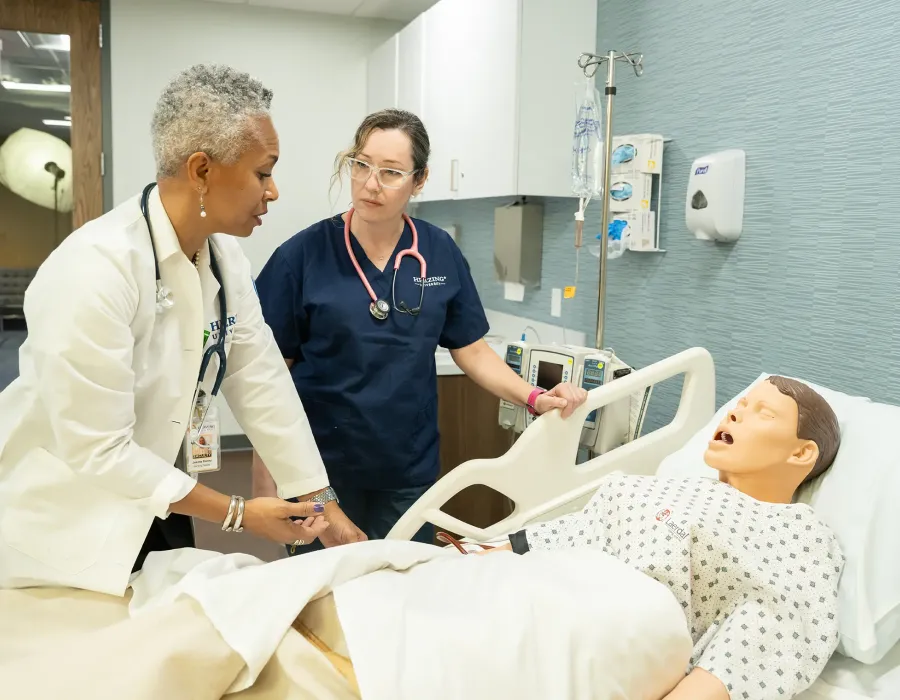Program availability
Your Preferences
Update your Zip code, preferred campus, and preferred program

What Does an Licensed Practical Nurse (LPN) Do?
Learn about what a practical nurse does, and how you can take the first step to qualify for entry-level jobs in the growing field of nursing.
Exploring the basic roles and responsibilities of a practical nurse
In healthcare systems across the country, practical nurses and Registered Nurses (RN) work in tandem to deliver basic and advanced nursing care in many types of healthcare institutions.
With a relatively short training period (you can potentially complete an educational program in as little as 12 months/1 year) becoming an LPN can be a rewarding and fulfilling career choice, and represents a head start towards potentially pursuing the RN career path in the future.
Here is an overview of LPN duties, educational requirements, career paths and more.
LPN duties and responsibilities
A licensed practical nurse (LPN) is a nurse that provides basic patient care and education. LPNs work under the supervision of registered nurses (RNs), doctors and other healthcare providers.
Each state has specific regulations about what duties an LPN can perform. Because of this, LPN duties may vary depending on where an LPN works.
LPN responsibilities can include:
- Patient monitoring. LPNs closely monitor patients' health by checking vital signs, such as blood pressure, temperature, pulse, and respiration rate. They can take patient histories and also perform physical exams.
- Basic medical care. LPNs can take patient histories and perform physical exams, as well as administer basic medical care, including changing bandages, inserting catheters, and assisting with wound care.
- Administer certain medicine. Depending on the state, LPNs may also administer IVs, PO (Per Os, per mouth/oral administration), IM (Intramuscular) or subcutaneous injections.
- Comfort care. LPNs provide essential care to patients, helping them with daily living activities, like bathing, dressing, and feeding.
- Record keeping. LPNs document all patient observations, treatments, and medications administered, to ensure accurate records.
- Reporting. LPNs communicate patients’ health statuses to physicians and other healthcare providers, ensuring timely, proper, and effective care.
- Communication. LPNs actively listen to patient concerns and discuss the care plan with patients and their families. They also provide education to patients and their families about care plans and medications.
LPN education, licensing and certification
LPN programs typically take 12 months and award a career diploma rather than a degree. Classes in the program typically focus on nursing fundamentals, growth and development, and pharmacology.
LPN programs also include in-person clinicals, where students get hands-on experience assisting patients under a nurse instructor’s supervision.
Once you have completed your LPN program requirements, you can take the National Council Licensing Examination for Practical Nurses exam (NCLEX-PN).
After earning your license, you may choose to pursue a certification in a specific area of nursing, such as cardiac care, wound care, and long-term care.
Open doors to new possibilities as an LPN

"Becoming an LPN as a young mother was one of the most pivotal decisions of my life. It wasn’t just a career move—it was a bridge that opened doors into the world of nursing. It gave me the freedom to explore different specialties, find my true passion, and still prioritize raising and caring for my family.
For you, becoming an LPN can be a powerful steppingstone—a launchpad into further education and advanced roles—or it can be your ultimate, fulfilling destination in nursing. The beauty is that the choice is entirely yours.
My journey started as an LPN and evolved: I earned my ADN, achieved my BSN, pursued my PMHNP, and ultimately completed my DNP. Each step shaped me into the nurse and leader I am today. I wouldn’t change a thing—and neither will you, if you embrace your path with courage and determination."
Dr. Monique Scott DNP, PMHNP-BC
Program Chair - Psychiatric Nurse PractitionerDr. Monique Scott is a Board-certified Psychiatric Nurse Practitioner with over 18 years of combined nursing and advanced practice experience, specializing in child and adolescent psychiatry, chronic mental health disorders, and geriatric psychiatry. She serves as the Program Chair for Herzing University’s PMHNP program, bringing a passion for mentorship and community-based mental health education. An alumna of New York University and Wilkes University, Dr. Scott is committed to preparing future nurse practitioners to provide compassionate, evidence-based care to diverse populations.
LPN versus LVN: What’s the difference?
The terms LPN (licensed practical nurse) and LVN (licensed vocational nurse) are often used interchangeably. Both LPNs and LVNs perform basic nursing duties, work under the supervision of a nurse or doctor, and must pass the National Council Licensure Examination for Practical Nurses (NCLEX-PN) exam to become licensed.
The main difference between an LPN and LVN is the state in which they work. While most states use the term LPN, some states distinguish the role as LVN, even though the two roles are essentially the same.
LPN workplaces and unique responsibilities
LPNs work in a variety of settings beyond hospitals. Each work environment offers unique responsibilities. Some examples include:
- Nursing homes: LPNs in nursing homes provide direct patient care to elderly residents. They may administer medications, monitor vital signs, assist with wound care, and help residents with activities of daily living.
- Clinics: In clinics, LPNs assist physicians with patient examinations, prepare patients for procedures, administer medications, and educate patients on health conditions.
- Correctional facilities: LPNs in correctional facilities provide healthcare services to inmates. They may assess medical needs, administer medications, and manage chronic conditions.
- Schools: School nurses (often LPNs) provide basic healthcare services to students. They administer medications, assess injuries, and provide health education.
LPN vs. related healthcare roles
Licensed practical nurses work with a variety of healthcare providers, including registered nurses, certified nursing assistants, and patient care technicians. While they may work closely together as a team, each job has unique duties.
- Registered nurses (RNs) have a broader scope of practice vs. LPNs, including assessing patient conditions, developing care plans, administering medications (including IVs), and managing patient care.
- Certified nursing assistants (CNAs) and patient care technicians (PCTs): CNAs and PCTs provide basic patient care, such as assisting with bathing, dressing, and feeding. They also monitor vital signs.
Both CNAs and PCTs need a high school diploma or GED and must complete a training program. A CNA training can be completed in several weeks. PCT training is more advanced and covers more topics, including phlebotomy and respiratory care, and may take a few months to complete.
Travel practical nurses
Travel LPNs relocate to different cities or states for short-term assignments, often in areas with high demand for healthcare professionals. They may work in a variety of environments, including hospitals, clinics, and long-term care facilities, and provide basic patient care and education.
Travel LPNs may work for a staffing agency or on a freelance basis. They can work in remote locations or near their home. Some people choose to become travel LPNs to see different areas, have more flexibility, and the opportunity to earn higher pay rates than staff nurses.
Start your LPN path today
Becoming an LPN allows you to directly impact people’s lives while beginning to build a rewarding career in healthcare.
It’s a great time to pursue your LPN diploma! Start your path today at Herzing.
Learn more about the Herzing University practical nursing program
* Bureau of Labor Statistics (BLS), U.S. Department of Labor, Occupational Employment and Wage Statistics 2023 / Occupational Outlook Handbook 2022. BLS estimates do not represent entry-level wages and/or salaries. Multiple factors, including prior experience, age, geography market in which you want to work and degree field, will affect career outcomes and earnings. Herzing neither represents that its graduates will earn the average salaries calculated by BLS for a particular job nor guarantees that graduation from its program will result in a job, promotion, salary increase or other career growth.
